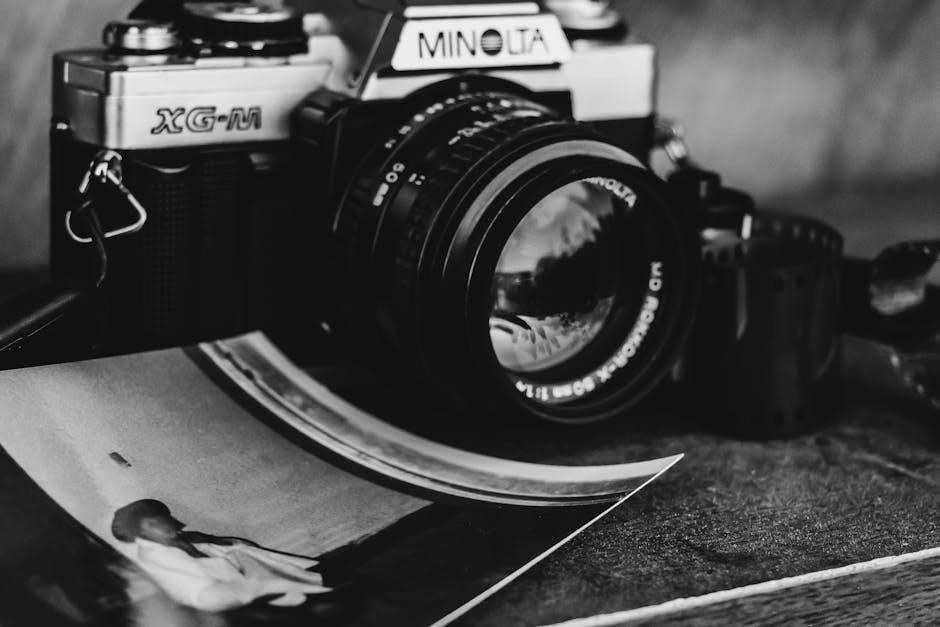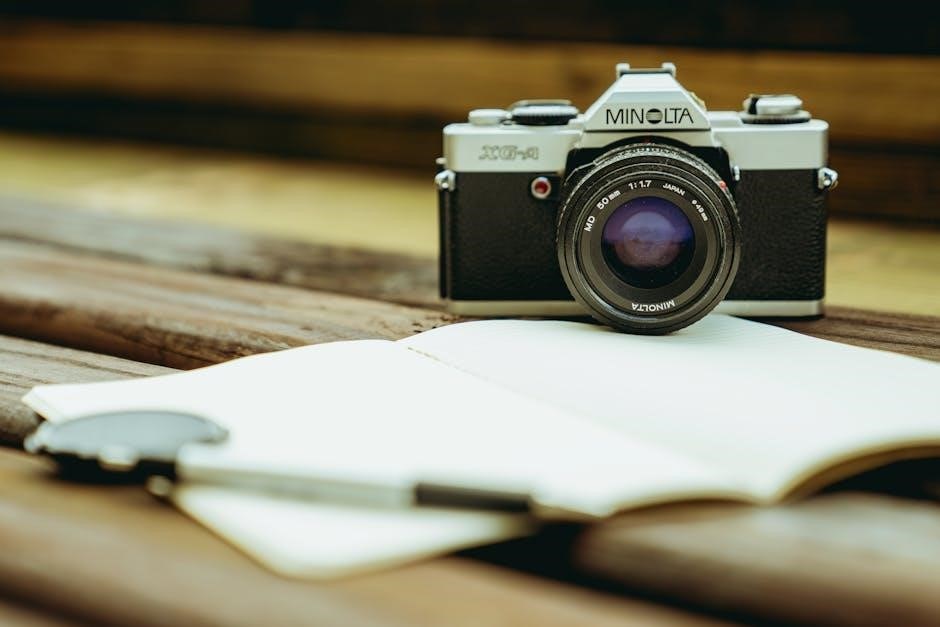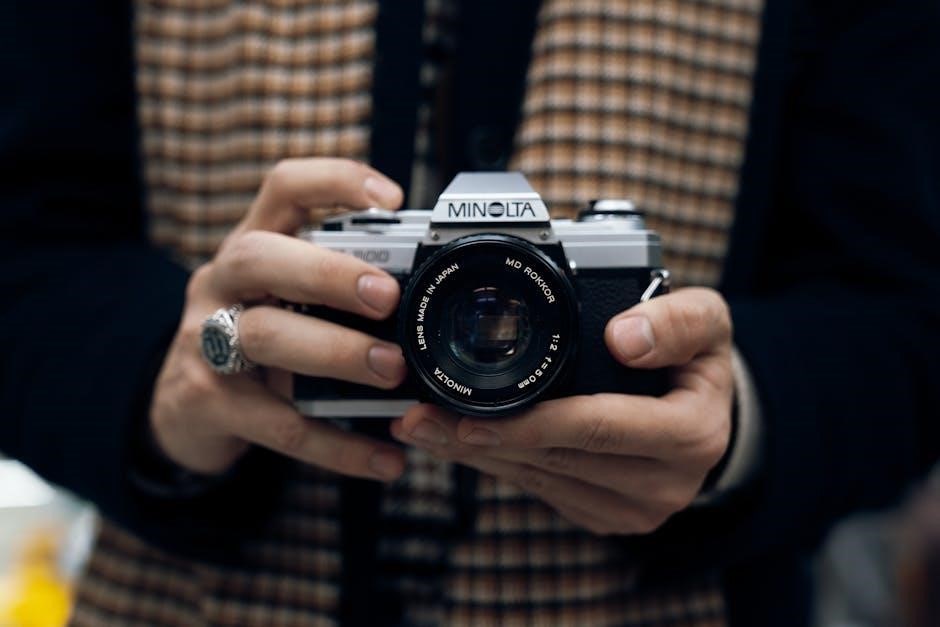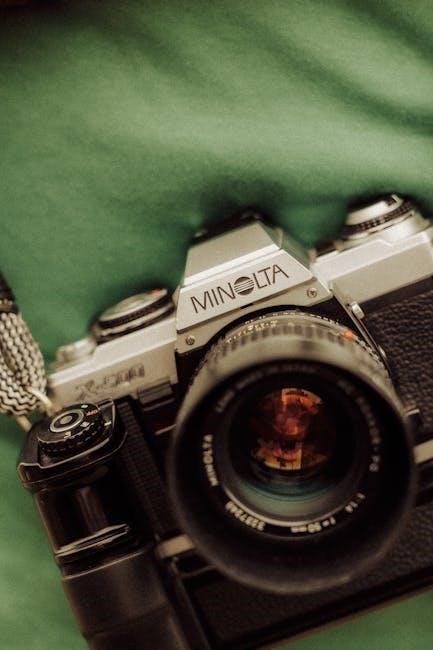Minolta Maxxum 7000 Manual: A Comprehensive Guide
The Minolta Maxxum 7000, a pioneering autofocus SLR camera, holds a significant place in photographic history. This comprehensive guide aims to provide users with a detailed understanding of the camera’s features and functions, assisting both new users and those rediscovering this classic piece of equipment.
The Minolta Maxxum 7000, known as the Dynax 7000 in Europe and the Alpha 7000 in Japan, is a 35mm SLR film camera that revolutionized photography with its integrated autofocus system. Released in 1985, it was among the first cameras to feature both autofocus and motorized film advance built into the camera body, marking a significant leap from manual focus SLRs.
This camera boasts various functionalities, including multiple exposure modes, spot metering, and compatibility with a wide range of Minolta A-mount lenses. The Maxxum 7000 employs computer technology to bring new dimensions to photography, offering a key control system and centralized data display. This made it accessible and appealing to both amateur and professional photographers.
Understanding the Maxxum 7000’s features and operation can unlock its full potential, allowing users to capture stunning photos with a classic touch. Whether you are a seasoned film photographer or new to the world of analog photography, the Minolta Maxxum 7000 offers a unique and rewarding experience.
Availability of the Manual
Finding a physical copy of the Minolta Maxxum 7000 manual can be challenging, given the camera’s age. However, numerous online resources offer digital versions that can be easily accessed and downloaded. Many enthusiast websites and camera manual libraries provide PDF versions of the manual, often free of charge.
These digital manuals are invaluable for understanding the camera’s features and troubleshooting any issues that may arise. Websites dedicated to preserving photographic history, such as Michael Butkus’s camera manual library, are excellent places to start your search. Additionally, online marketplaces like eBay sometimes offer original printed manuals for sale.
When downloading a digital manual, ensure it is from a reputable source to avoid corrupted files or inaccurate information. Cross-referencing information from multiple sources can also be helpful. Whether you prefer a digital or physical copy, having access to the Minolta Maxxum 7000 manual is essential for getting the most out of this classic camera.

Key Features and Functions
The Minolta Maxxum 7000 boasts a range of features that made it a groundbreaking camera for its time. Understanding these features is essential for effectively utilizing the camera and capturing high-quality photographs. This section will delve into the key aspects of the Maxxum 7000.
Overview of Camera Parts
Familiarizing yourself with the Minolta Maxxum 7000’s components is crucial for optimal operation. The camera’s front houses the lens mount, accepting Minolta A-mount lenses. The lens release button allows for lens changes. Above the lens is the built-in light meter sensor. The top panel features the shutter speed dial, mode dial, and drive mode selector.
The data panel displays critical information such as shutter speed, aperture, and exposure compensation. The shutter release button, with its surrounding power switch, initiates the exposure. The film advance lever, after each shot, prepares the camera for the next.
The camera’s rear includes the viewfinder, providing the user’s perspective. The film rewind knob facilitates film retrieval. The back cover release opens the camera for film loading; Inside, the film chamber houses the film cartridge and take-up spool. The battery compartment, typically located at the base, powers the camera’s functions. Understanding these parts ensures confident handling and control. The availability of comprehensive manuals further aids in navigating the camera’s features. The user manual offers detailed diagrams and explanations to fully grasp each component’s purpose.
Loading Film
Proper film loading is essential for capturing images with the Minolta Maxxum 7000. Begin by ensuring the camera is switched off to prevent accidental exposure. Open the camera back by sliding the back cover release downwards. This reveals the film chamber. Insert the film cartridge into the left side, pushing it in securely.
Next, pull the film leader across the film plane and insert its tip into one of the take-up spool slots. Ensure the film sprockets align with the corresponding pins along the film path. Gently advance the film using the film advance lever. Observe that the film is winding correctly onto the take-up spool. Close the camera back, ensuring it clicks shut.
Advance the film twice, or as needed, until the frame counter displays “1”. This clears any fogged film exposed during loading. Your Minolta Maxxum 7000 is now ready to capture your photographic vision. Always load film in subdued light to avoid unwanted exposure.
Consult the camera’s manual for detailed illustrations and specific instructions. This ensures the process is followed correctly, and you are ready to enjoy your photographic journey.
Setting Film Speed
Accurately setting the film speed (ISO) on your Minolta Maxxum 7000 is crucial for proper exposure. The camera relies on this setting to correctly measure light and determine the appropriate aperture and shutter speed. The Maxxum 7000 offers both DX coding and manual ISO setting capabilities.
For films with DX coding, the camera automatically reads the ISO from the cartridge. Ensure the DX contacts within the film chamber are clean for accurate reading. If using film without DX coding, or if you desire to override the DX setting, you must manually set the ISO.
Locate the ISO setting dial, typically found on the top of the camera. Rotate the dial until the desired ISO value aligns with the indicator mark. Double-check the setting to avoid errors. Common ISO values include 100, 200, 400, and 800.
Consult your film’s packaging to determine its ISO. Incorrect ISO settings can lead to over or underexposed images. Understanding and correctly setting the film speed will significantly improve your photographs. Refer to the manual to further understand ISO settings.
Exposure Modes
The Minolta Maxxum 7000 offers a range of exposure modes to cater to various shooting scenarios. Understanding these modes is key to achieving desired photographic results. The camera provides Program (P), Aperture Priority (A), Shutter Priority (S), and Manual (M) modes.
In Program mode, the camera automatically selects both aperture and shutter speed, offering convenience for general shooting. Aperture Priority allows you to set the aperture, controlling depth of field, while the camera selects the corresponding shutter speed. Shutter Priority lets you set the shutter speed, useful for freezing motion or creating motion blur, with the camera choosing the appropriate aperture.
Manual mode grants complete control over both aperture and shutter speed, enabling creative experimentation and precise exposure adjustments. To select an exposure mode, locate the mode dial on the camera body. Rotate the dial to the desired setting.
Each mode offers unique advantages. Experiment with each to discover how they affect your images. Understanding and utilizing these exposure modes will empower you to capture stunning photographs in diverse conditions. Refer to the camera’s manual for detailed explanations.
Autofocus System
The Minolta Maxxum 7000 revolutionized photography with its advanced autofocus (AF) system. This system allows for quick and precise focusing, ensuring sharp images. The camera employs a single autofocus sensor located in the center of the viewfinder. To activate autofocus, half-press the shutter button. The camera will then attempt to lock focus on the subject within the sensor’s area.
The Maxxum 7000 offers both single and continuous autofocus modes. In single AF mode, the camera locks focus when the shutter button is half-pressed; This mode is ideal for stationary subjects. Continuous AF mode continuously adjusts focus as long as the shutter button is half-pressed, suitable for moving subjects.
The autofocus system relies on contrast detection. It analyzes the contrast of the subject to determine focus accuracy. In low-light conditions or with low-contrast subjects, autofocus performance may be affected. Manual focus can be engaged by setting switch to manual focus mode. Understanding these modes will help you master the autofocus system.

Troubleshooting
Even with its advanced features, the Minolta Maxxum 7000 can sometimes encounter issues. One common problem is the camera failing to power on. Ensure that the batteries are fresh and correctly installed. Check the battery contacts for corrosion and clean them if necessary. Another issue is the film not advancing properly. Make sure the film is loaded correctly and that the film advance mechanism is not obstructed.
Autofocus problems can also arise. In low light or low contrast situations, try switching to manual focus. If the viewfinder is blurry, adjust the diopter correction dial near the eyepiece. Exposure problems, such as over or underexposed images, can often be attributed to incorrect exposure settings. Double-check the aperture, shutter speed, and ISO settings. Resetting the camera to its default settings can sometimes resolve unexpected behavior. By addressing these common issues, you can maintain the Maxxum 7000.

Maintenance and Care
Proper maintenance is essential for prolonging the life of your Minolta Maxxum 7000. Regularly clean the camera’s exterior with a soft, dry cloth to remove dust and fingerprints. Avoid using harsh chemicals or solvents, as these can damage the finish. The lens should be cleaned with a lens cleaning cloth and solution specifically designed for camera lenses. Store the camera in a cool, dry place, away from direct sunlight and extreme temperatures.
When not in use for extended periods, remove the batteries to prevent corrosion. Periodically inspect the battery contacts for any signs of corrosion and clean them if necessary. The film compartment should also be cleaned regularly to remove any dust or debris. If you notice any unusual noises or malfunctions, it’s best to consult a qualified camera technician. Regular maintenance will ensure the Maxxum 7000 remains reliable.

Where to Find Additional Resources
For Minolta Maxxum 7000 enthusiasts seeking further information and support, several online resources are available. Websites such as Butkus.org offer a wealth of camera manuals, including the Minolta Maxxum 7000 instruction manual, available for free download. These manuals provide detailed information on the camera’s features and operation.
Online photography forums and communities are great for connecting with fellow Maxxum 7000 users, sharing experiences, and seeking advice. Websites like eBay are useful for finding original accessories and parts for the camera. YouTube channels often feature tutorials and reviews of vintage cameras, including the Minolta Maxxum 7000. Additionally, local camera repair shops may offer services and expertise for maintaining and repairing the camera. Exploring these resources will enhance your knowledge and enjoyment of the Minolta Maxxum 7000.
